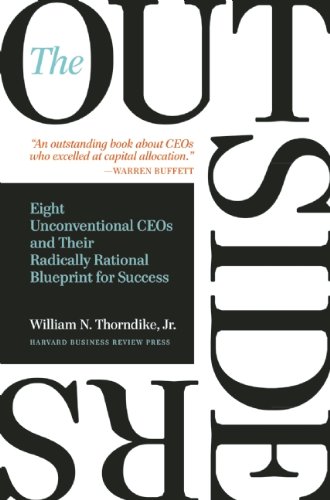

This article is an excerpt from the Shortform summary of "The Outsiders" by William N. Thorndike, Jr. Shortform has the world's best summaries of books you should be reading.
Like this article? Sign up for a free trial here .
How did Warren Buffett become one of the most successful CEOs of all time? And what is the Warren Buffet value investing strategy?
Born in 1930 in Omaha, Nebraska, Warren Buffett was the son of a stockbroker and the grandson of a grocery store owner. His early entrepreneurial activities included paper routes and reselling soft drinks. His business grew over time, and so did Warren Buffett’s value investing strategy, moving from strictly value investing into and investing style that included more complex stocks for the long term.
Early Strategy: Warren Buffett’s Value Investing
When he was 19, Warren Buffett read The Intelligent Investor by Benjamin Graham, which converted him into value investing—buying companies that were cheap relative to their intrinsic value (which was based on the company’s balance sheet). He began investing the profits from his ventures, worth about $10,000 in today’s dollars.
But in the mid-1960s, Warren Buffett’s value investing strategy began to change. Buffett began deviating from the value method, instead investing in high-quality companies that had a strong competitive profile and long-term prospects. His early investments in this style included Disney and American Express.
In 1965, Buffett purchased the textile company Berkshire Hathaway, a 100-year-old family business, through a hostile takeover. The company was only worth $18 million in enterprise value and was in a commodity business, but Buffett saw it as a platform to build his investments around. After installing a new CEO, who optimized operations, Berkshire Hathaway had $14 million of profit.
Buffett used this profit to buy National Indemnity, an insurance company that generated a large amount of float—the value of premiums received before they are paid out as claims. Insurance companies rely on investment returns from float to generate a profit; sometimes years can pass between when premiums are received and when they need to be paid out. In essence, Berkshire was able to receive cash at 3% and invest it at 13%. Buffett used this float to invest in businesses, sometimes buying them outright. His purchases included a newspaper in Omaha and a local bank in Illinois. Warren Buffett’s value investing strategy continued while he also purchased companies outright.
One example is illustrative—in 1972, Buffett purchased See’s Candies for $25 million, when it had $7 million in book value and $4.2 million in pretax profits. At 3 times book value, it would have been too expensive for Graham, but at 6 times pretax income and strong brand loyalty, it was a reasonable purchase. Over the decades, See’s Candies has not grown unit sales tremendously, but its strong brand allowed it to raise prices consistently. See’s earned a 32% annual return over 27 years and has provided $1.65 billion in cash flow. This shows Warren Buffett’s value investing changing and evolving over time, and incorporating other investing styles.
New Strategy: High Value for Long-Term Companies
Throughout the 1970s and 1980s, Warren Buffett’s value investing strategy changed slightly. Warren Buffett’s investing style thus began investing in high-quality, enduring companies, such as the Washington Post, GEICO, and General Foods. He both made minority investments and purchased companies outright, such as with See’s Candies and the Nebraska Furniture Mart.
Insurance Float
Warren Buffet’s investing style was further honed in the 1970s, as inflation was a common concern among investors. The typical thinking was that hard assets like gold were the best protection against inflation. Buffett saw differently, and developed key components of his investment thesis:
- He believed that companies that had the ability to raise prices and that had low capital requirements were best protected against inflation. These companies included beloved consumer brands that were market leaders.
- The best way to value a company was based on income statement and cash flows, as well as intangibles like brand power and market share. This was a departure from Graham’s method of using balance sheet and net working capital.
- To avoid leakage of growth to taxes, Buffett would prefer holding investments for a long time. This allowed for longer periods of compounding growth without paying taxes on exiting positions.
A big part of Warren Buffett’s value investment strategy and Warren Buffett’s investing style is its use of low-cost insurance float to invest in higher-return businesses. As a reminder, insurance float is money the company receives in premiums before they are paid out as claims. The time gap can be many years. In essence, this is like getting cash at 3% to reinvest at 13%.
Over the years, Berkshire continued scaling up the strategy in an accelerating flywheel effect. He could use insurance float to purchase companies that generated cash flow, which in turn he could use to buy more insurance companies, which generated more float to purchase companies. Insurance float grew from $237 million in 1970 to $70 billion in 2011.
As a large diversified company, Buffett also had more control over his insurance companies’ underwriting to maximize profitability. When premium pricing was low, Buffett’s insurance companies would underwrite fewer premiums; when pricing was high, it would take advantage by underwriting multiple-fold more in premiums. For instance, between 1984 to 1986, premiums grew sixfold, then shrank 73% by 1989. It’d be difficult for an independent public insurer to do the same, since its investors expect smooth performance. So while Warren Buffett’s value investing strategy remained at the core of his ideas, he was able to adjust to keep up with changing industry.
A Wide Range of Investment Options
Warren Buffett’s value investing meant he had extensive experience in investing before starting Berkshire Hathaway. So, Buffett had a wider range of investment options than most CEOs. Typical CEOs only look within their immediate industry. In contrast, Buffett has made investments in a vast array of industries (from beverages to industrials). Even his investments take a wide range of flavors, including investments in both private and public companies, both minority investments and complete acquisitions, and at times making big bets in bonds and currencies.
Opportunistic Temperament
Buffett has said that as an investor, it’s important to be “fearful when others are greedy, and greedy when others are fearful.”
Buffett is content to be patient for years when companies are overvalued and he doesn’t see acceptable opportunities. Then, when other investors are in turmoil (as in the 2008 financial crisis), Buffett strikes aggressively.
Beyond larger trends, Buffett enjoys finding opportunities within industries and individual companies. Pessimism within an industry can obscure strong performers within the industry—Buffett invested in Freddie Mac in 1989 during the recession, and in General Dynamics in 1992 during the defense industry slump. He also finds companies in the midst of a major strategic change, such as when a new CEO announces a focus on the company core and divestments of low-performing businesses.
This also means being ruthless about not tolerating poor performance and low returns. When Buffett purchased Berkshire Hathaway in 1965, he chose never to enter textiles again, seeing it as a commodity business with poor long-term prospects. Instead, he merely harvested capital from Berkshire and invested it elsewhere. Choosing what not to do is often as important as choosing what to do when following Warren Buffett’s value investing style.
Centralization of Investments
However, like most other outsider CEOs, Buffett is completely centralized in capital allocations. All capital flows to headquarters to allocate. Buffett personally takes charge of negotiations, and he does not rely on investment bankers or business development to make deals.
Buffett also believes in having a relatively small board, and requiring all board directors to have a personal stake in decisions. This means:
- A meaningful investment of personal capital into the business
- No insurance
- Avoiding fees that represent a large percent of the director’s income
This aligns board members much better with the performance of the business. In contrast, board members who have little ownership in the business, have insurance that protects them from downside, and are paid large fees are far less interested in guiding the company correctly, and are less likely to fit into Warren Buffett’s value investing and management philosophies.
Acquisition Style
Buffett is remarkably quick at making a purchase decision. He spends less time on due diligence and often makes deals within days. He never visits company locations and rarely meets management. He can move quickly because he only invests in industries he knows deeply, and he has honed his investment criteria. This lets him filter the key performance indicators of a business.
Buffett also avoids auctions, believing they drive up valuation needlessly. He prefers that owners call him and offer a price, with Buffett returning his answer within 5 minutes.
People all over the world aim to emulate Warren Buffett’s investment style, hoping to achieve some semblance of his success. Warren Buffett’s value investing experience has helped catapult him to the top of the business world.

———End of Preview———
Like what you just read? Read the rest of the world's best summary of William N. Thorndike, Jr's "The Outsiders" at Shortform .
Here's what you'll find in our full The Outsiders summary :
- What great CEOs like Warren Buffett do that average CEOs don't
- How to master the art of capital allocation
- How to be a great manager that your team is excited to work with






